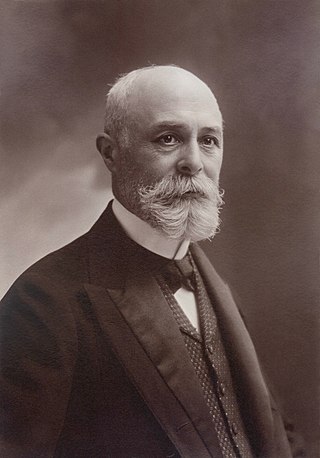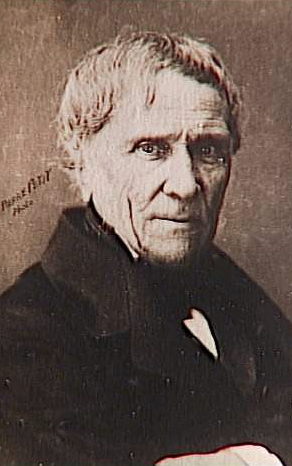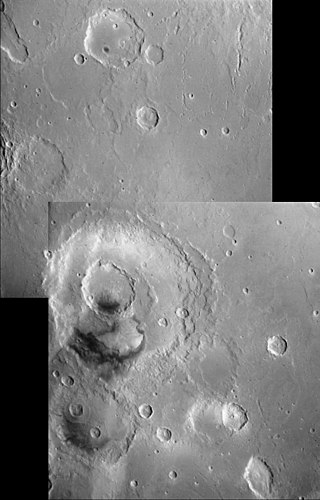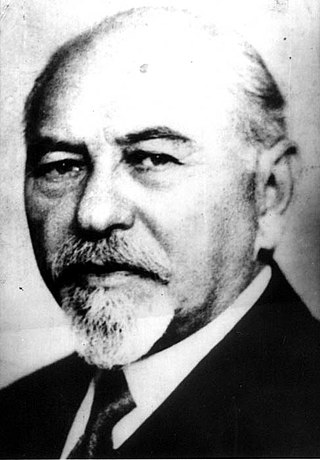The becquerel (symbol: Bq) is the SI derived unit of radioactivity, named after Henri Becquerel.
Contents
Becquerel may also refer to:
The becquerel (symbol: Bq) is the SI derived unit of radioactivity, named after Henri Becquerel.
Becquerel may also refer to:

Maria Salomea Skłodowska-Curie, known simply as Marie Curie, was a Polish and naturalised-French physicist and chemist who conducted pioneering research on radioactivity. She was the first woman to win a Nobel Prize, the first person to win a Nobel Prize twice, and the only person to win a Nobel Prize in two scientific fields. Her husband, Pierre Curie, was a co-winner of her first Nobel Prize, making them the first-ever married couple to win the Nobel Prize and launching the Curie family legacy of five Nobel Prizes. She was, in 1906, the first woman to become a professor at the University of Paris.

Pierre Curie was a French physicist, a pioneer in crystallography, magnetism, piezoelectricity, and radioactivity. In 1903, he received the Nobel Prize in Physics with his wife, Marie Skłodowska–Curie, and Henri Becquerel, "in recognition of the extraordinary services they have rendered by their joint researches on the radiation phenomena discovered by Professor Henri Becquerel". With their win, the Curies became the first ever married couple to win the Nobel Prize, launching the Curie family legacy of five Nobel Prizes.

Antoine Henri Becquerel was a French engineer, physicist, Nobel laureate, and the first person to discover radioactivity. For work in this field he, along with Marie Skłodowska-Curie and Pierre Curie, received the 1903 Nobel Prize in Physics. The SI unit for radioactivity, the becquerel (Bq), is named after him.

The becquerel is the unit of radioactivity in the International System of Units (SI). One becquerel is defined as an activity of one decay per second. For applications relating to human health this is a small quantity, and SI multiples of the unit are commonly used.

Radioactive decay is the process by which an unstable atomic nucleus loses energy by radiation. A material containing unstable nuclei is considered radioactive. Three of the most common types of decay are alpha, beta, and gamma decay. The weak force is the mechanism that is responsible for beta decay, while the other two are governed by the electromagnetism and nuclear force.

Nuclear chemistry is the sub-field of chemistry dealing with radioactivity, nuclear processes, and transformations in the nuclei of atoms, such as nuclear transmutation and nuclear properties.

Alexandre-Edmond Becquerel, known as Edmond Becquerel, was a French physicist who studied the solar spectrum, magnetism, electricity and optics. He is credited with the discovery of the photovoltaic effect, the operating principle of the solar cell, in 1839. He is also known for his work in luminescence and phosphorescence. He was the son of Antoine César Becquerel and the father of Henri Becquerel, one of the discoverers of radioactivity.

The French National Museum of Natural History, known in French as the Muséum national d'histoire naturelle, is the national natural history museum of France and a grand établissement of higher education part of Sorbonne Universities. The main museum, with four galleries, is located in Paris, France, within the Jardin des Plantes on the left bank of the River Seine. It was formally founded in 1793, during the French Revolution, but was begun even earlier in 1635 as the royal garden of medicinal plants. The museum now has 14 sites throughout France.

Antoine César Becquerel was a French scientist and a pioneer in the study of electric and luminescent phenomena.
Curie may refer to:
Henri is the French form of the masculine given name Henry, also in Estonian, Finnish, German and Luxembourgish.
Jean Antoine Edmond Marie Becquerel was a French physicist, the son of Antoine-Henri Becquerel. He worked on a range of experimental physics topics including magnetic effects on the optical properties of materials, and the effects of low-temperature on magnetic susceptibility. He was among the early teachers of relativity and quantum physics in France.
The rutherford is a non-SI unit of radioactive decay. It is defined as the activity of a quantity of radioactive material in which one million nuclei decay per second. It is therefore equivalent to one megabecquerel, and one becquerel equals one microrutherford. One rutherford is equivalent to 2.703 × 10−5 curie.
Fogging in photography is the deterioration in the quality of the image or the negative caused either by extraneous light, other electromagnetic radiation, radioactivity or the effects of a processing chemical. It is seen either as deposition of silver or dyes across all or part of the image unrelated to the original exposure. It can be confused with chemical staining that can be produced from poorly compounded developer, contamination of processing baths or poor washing after processing.
Pierre Adrien Joliot-Curie is a noted French biologist and researcher for the CNRS. A researcher there since 1956, he became a Director of Research in 1974 and a member of their scientific council in 1992. He was a scientific advisor to the French Prime Minister from 1985 to 1986 and is a member of Academia Europæa. He was made a commander of the Ordre National du Mérite in 1982 and of the Légion d'honneur in 1984.

Becquerel is a 167 km-diameter crater at 22.1°N, 352.0°E on Mars, in Arabia Terra in Oxia Palus quadrangle. It is named after Antoine H. Becquerel.
Events from the year 1852 in France.

Claude Félix Abel Niépce de Saint-Victor was a French photographic inventor. Claude was an army lieutenant and the cousin of Nicéphore Niépce. He first experimented in 1847 with negatives made with albumen on glass, a method subsequently used by Frederick Langenheim for his and his brother’s lantern slides. At his laboratory near Paris, Saint-Victor worked on the fixation of natural photographic colour as well as the perfection of his cousin's heliographing process for photomechanical printing. His method of photomechanical printing, called heliogravure, was published in 1856 in Traité pratique de gravure héliographique. In the 1850s, he also published frequently in La Lumière.

Dragomir M. Hurmuzescu was a Romanian physicist and inventor, teacher at the University of Iași and the University of Bucharest, and a correspondent member at the Romanian Academy.
The Becquerel family is a family of French scientists.